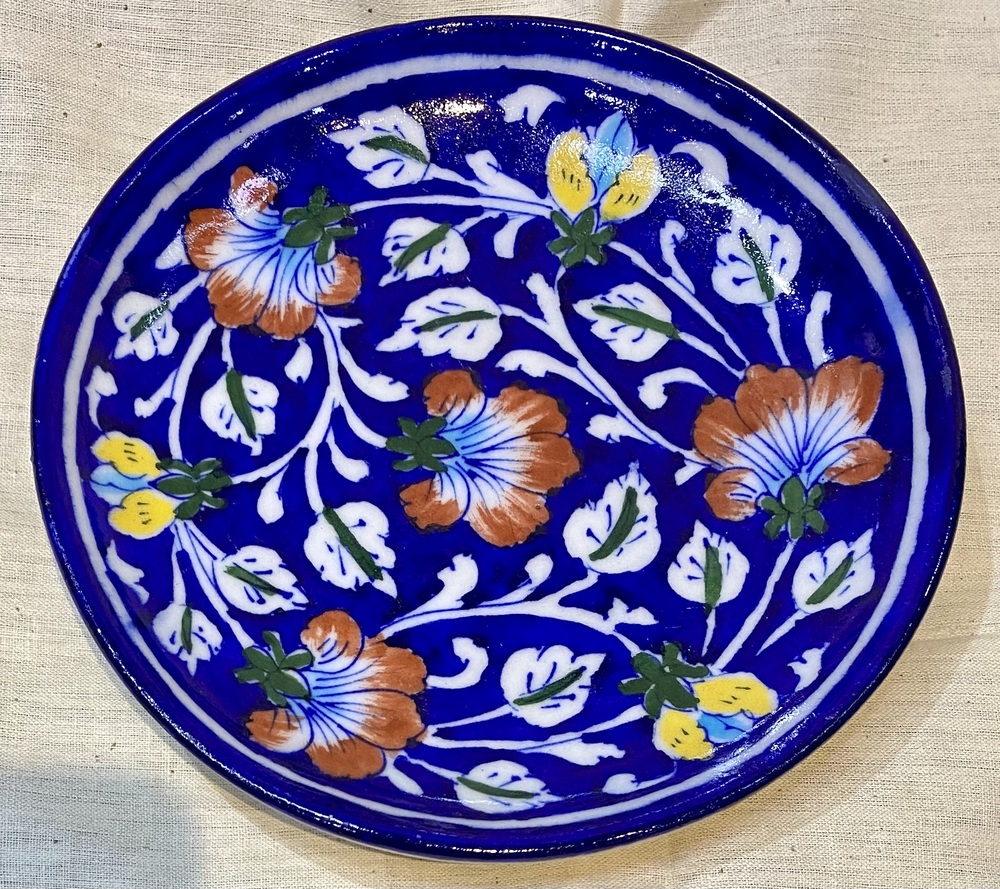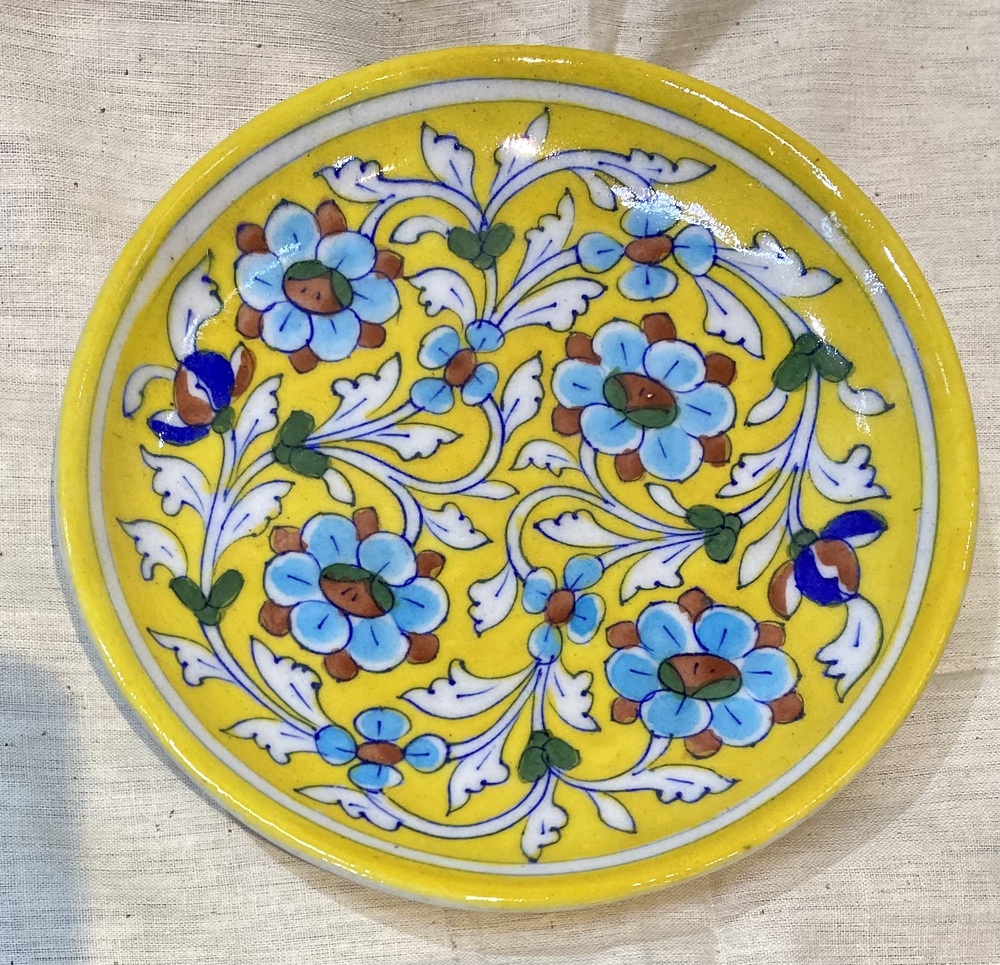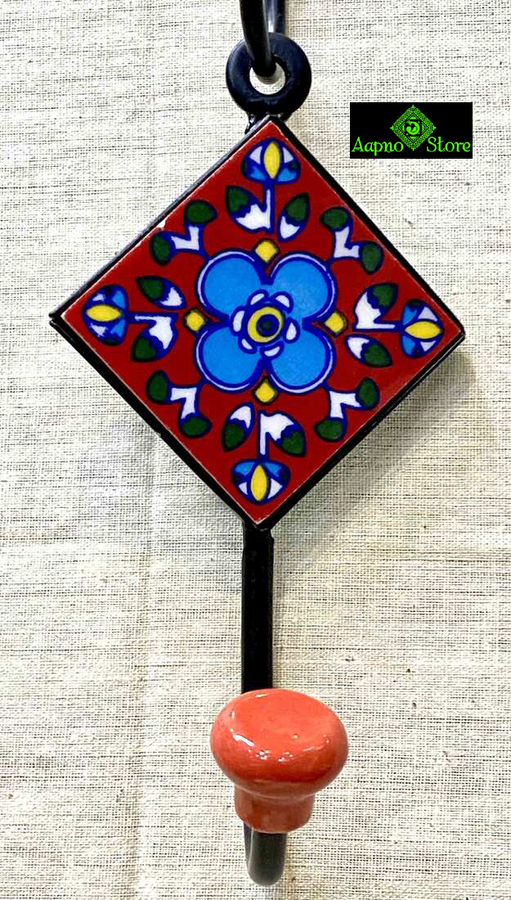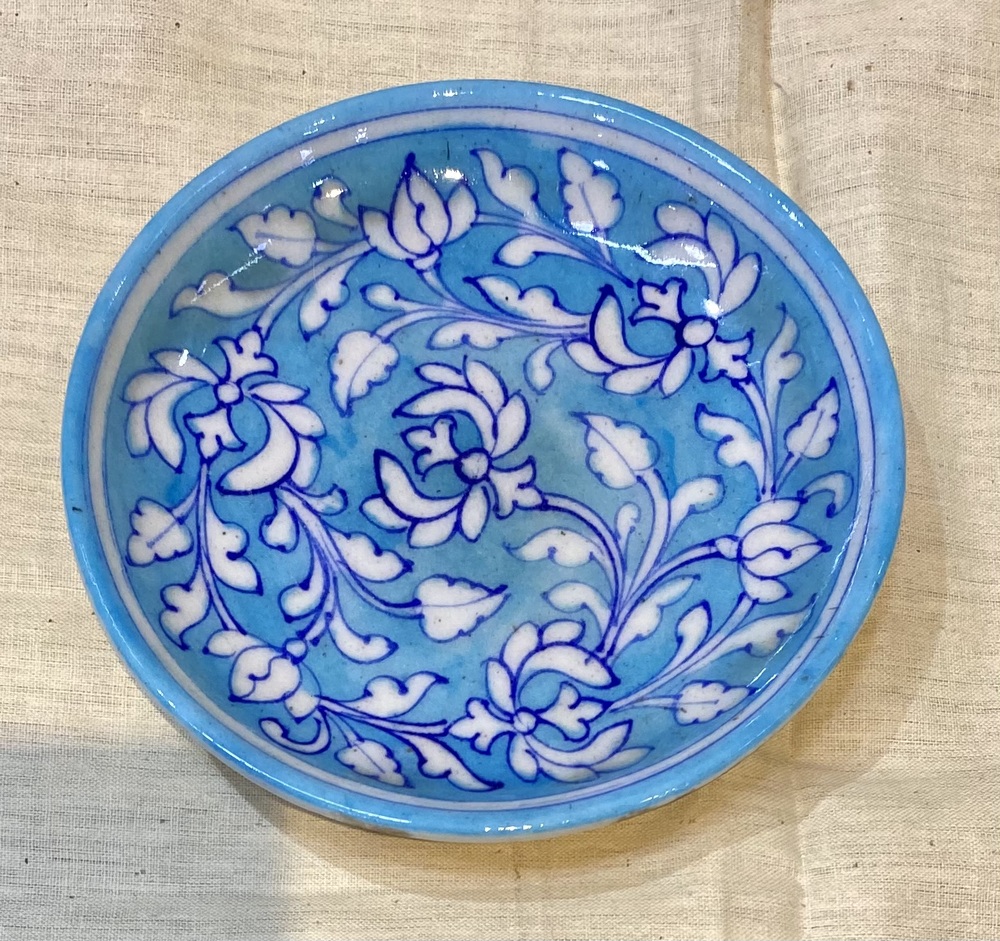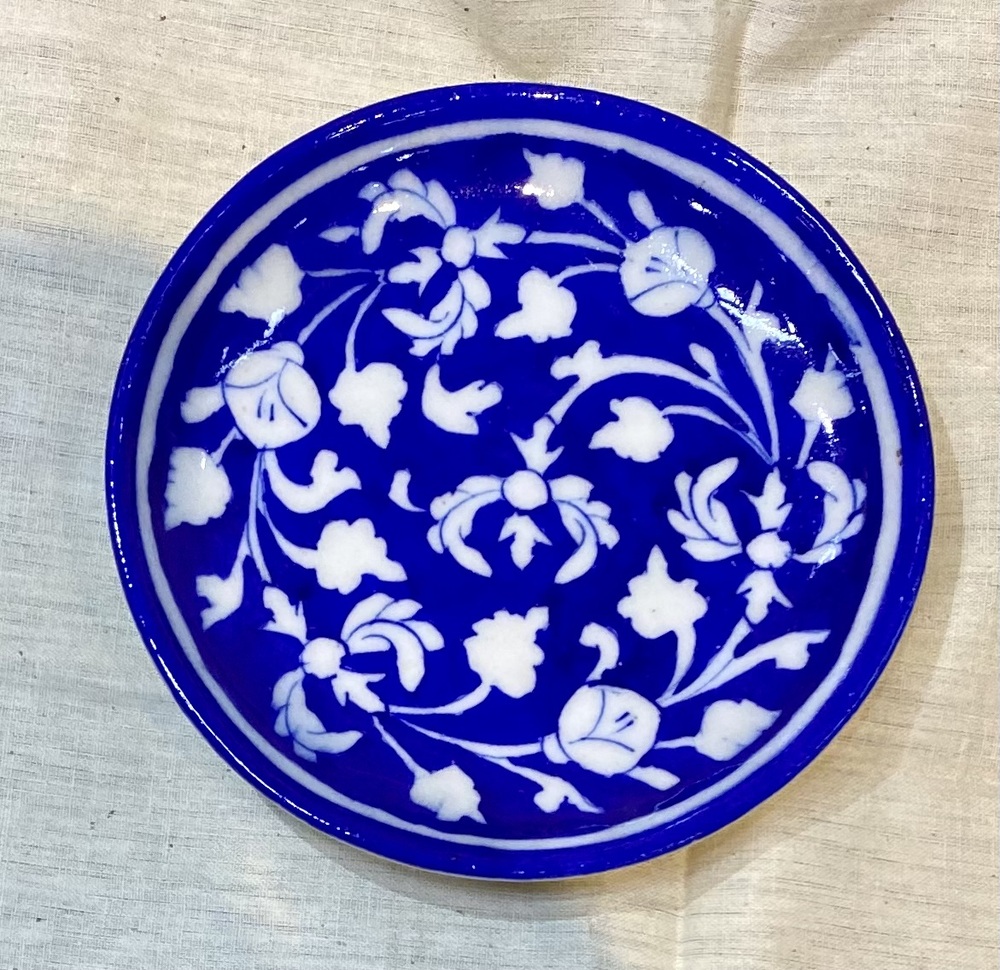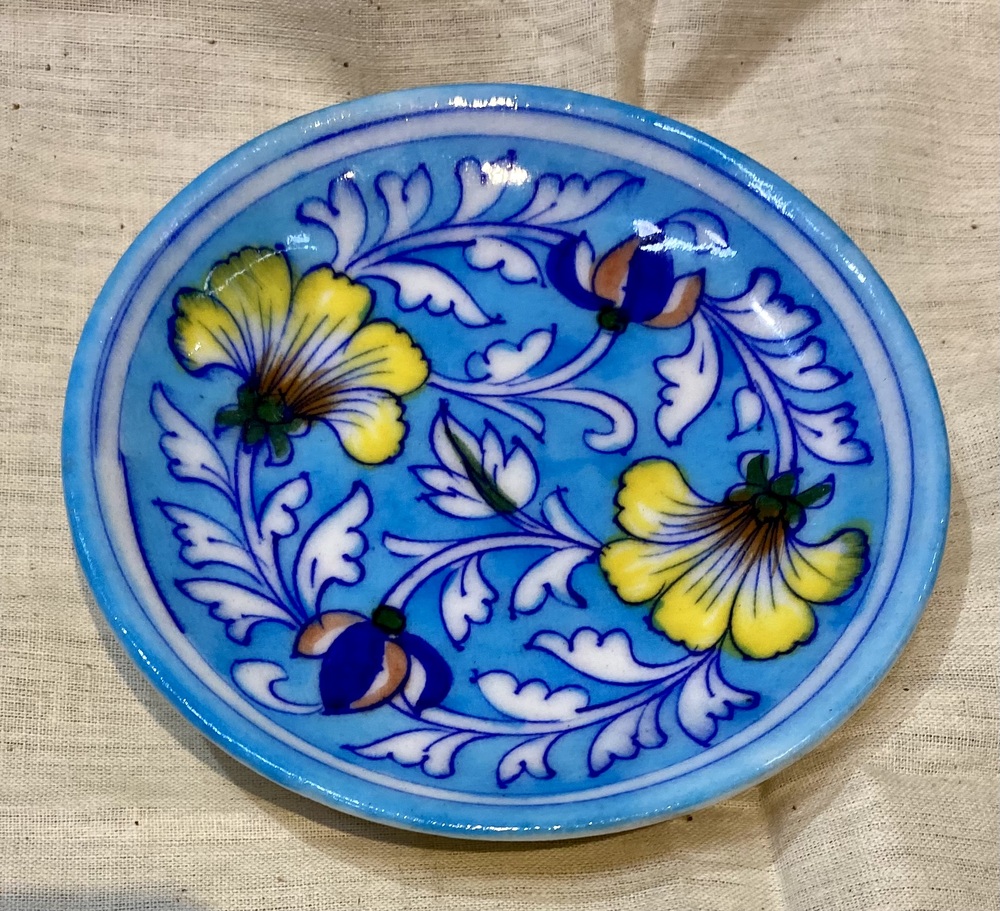-
0117CRH- 10″ JAIPUR BLUE POTTERY PLATE
Although it originated in ancient Persia, the art of blue pottery was brought to the craftsmen of Jaipur in the early 18th century. Blue pottery derives its name from the distinct use of Persian blue colour. Now it is called Jaipur Blue. Indeed, the precise hand-painting under a transparent glazed surface, makes blue pottery stand out; but there is lot more to blue pottery than what meets the eye. It is the only form of pottery in the world which is made without the use of natural clay or mud. Instead, a special combination of powdered quartz, glass pieces and other minerals is used to make the clay-like mixture for making blue pottery. Interestingly, Jaipur’s blue pottery is also the only form of low-temperature glazed pottery which is made with a single firing process. These unusual attributes have earned Jaipur’s blue pottery a lot of fame in its own niche in the international market.
₹875.00₹1,400.000117CRH- 10″ JAIPUR BLUE POTTERY PLATE
₹875.00₹1,400.00 -
0118CRH- 8″ JAIPUR BLUE POTTERY PLATE
Although it originated in ancient Persia, the art of blue pottery was brought to the craftsmen of Jaipur in the early 18th century. Blue pottery derives its name from the distinct use of Persian blue colour. Now it is called Jaipur Blue. Indeed, the precise hand-painting under a transparent glazed surface, makes blue pottery stand out; but there is lot more to blue pottery than what meets the eye. It is the only form of pottery in the world which is made without the use of natural clay or mud. Instead, a special combination of powdered quartz, glass pieces and other minerals is used to make the clay-like mixture for making blue pottery. Interestingly, Jaipur’s blue pottery is also the only form of low-temperature glazed pottery which is made with a single firing process. These unusual attributes have earned Jaipur’s blue pottery a lot of fame in its own niche in the international market.
₹750.00₹1,200.000118CRH- 8″ JAIPUR BLUE POTTERY PLATE
₹750.00₹1,200.00 -
0136CRH- JAIPUR BLUE POTTERY TILES ( SET OF 4 )
Although it originated in ancient Persia, the art of blue pottery was brought to the craftsmen of Jaipur in the early 18th century. Blue pottery derives its name from the distinct use of Persian blue colour. Now it is called Jaipur Blue. Indeed, the precise hand-painting under a transparent glazed surface, makes blue pottery stand out; but there is lot more to blue pottery than what meets the eye. It is the only form of pottery in the world which is made without the use of natural clay or mud. Instead, a special combination of powdered quartz, glass pieces and other minerals is used to make the clay-like mixture for making blue pottery. Interestingly, Jaipur’s blue pottery is also the only form of low-temperature glazed pottery which is made with a single firing process. These unusual attributes have earned Jaipur’s blue pottery a lot of fame in its own niche in the international market.
Blue Pottery Tiles can illuminate just about any piece of furniture or corner of the house.This tile can be used on walls as runners or borders. Not recommended for floors.Can be pasted on the wall with cement and on wood with glue solution.₹350.00₹480.000136CRH- JAIPUR BLUE POTTERY TILES ( SET OF 4 )
₹350.00₹480.00 -
0402CRH- JAIPUR BLUE POTTERY PLATE (WALL HANGING)
Although it originated in ancient Persia, the art of blue pottery was brought to the craftsmen of Jaipur in the early 18th century. Blue pottery derives its name from the distinct use of Persian blue colour. Now it is called Jaipur Blue. Indeed, the precise hand-painting under a transparent glazed surface, makes blue pottery stand out; but there is lot more to blue pottery than what meets the eye. It is the only form of pottery in the world which is made without the use of natural clay or mud. Instead, a special combination of powdered quartz, glass pieces and other minerals is used to make the clay-like mixture for making blue pottery. Interestingly, Jaipur’s blue pottery is also the only form of low-temperature glazed pottery which is made with a single firing process. These unusual attributes have earned Jaipur’s blue pottery a lot of fame in its own niche in the international market.
₹350.00₹500.000402CRH- JAIPUR BLUE POTTERY PLATE (WALL HANGING)
₹350.00₹500.00 -
0403CRH- JAIPUR BLUE POTTERY PLATE (WALL HANGING)
Although it originated in ancient Persia, the art of blue pottery was brought to the craftsmen of Jaipur in the early 18th century. Blue pottery derives its name from the distinct use of Persian blue colour. Now it is called Jaipur Blue. Indeed, the precise hand-painting under a transparent glazed surface, makes blue pottery stand out; but there is lot more to blue pottery than what meets the eye. It is the only form of pottery in the world which is made without the use of natural clay or mud. Instead, a special combination of powdered quartz, glass pieces and other minerals is used to make the clay-like mixture for making blue pottery. Interestingly, Jaipur’s blue pottery is also the only form of low-temperature glazed pottery which is made with a single firing process. These unusual attributes have earned Jaipur’s blue pottery a lot of fame in its own niche in the international market.
₹475.00₹700.000403CRH- JAIPUR BLUE POTTERY PLATE (WALL HANGING)
₹475.00₹700.00 -
0404CRH- JAIPUR BLUE POTTERY PLATE (WALL HANGING)
Although it originated in ancient Persia, the art of blue pottery was brought to the craftsmen of Jaipur in the early 18th century. Blue pottery derives its name from the distinct use of Persian blue colour. Now it is called Jaipur Blue. Indeed, the precise hand-painting under a transparent glazed surface, makes blue pottery stand out; but there is lot more to blue pottery than what meets the eye. It is the only form of pottery in the world which is made without the use of natural clay or mud. Instead, a special combination of powdered quartz, glass pieces and other minerals is used to make the clay-like mixture for making blue pottery. Interestingly, Jaipur’s blue pottery is also the only form of low-temperature glazed pottery which is made with a single firing process. These unusual attributes have earned Jaipur’s blue pottery a lot of fame in its own niche in the international market.
₹575.00₹900.000404CRH- JAIPUR BLUE POTTERY PLATE (WALL HANGING)
₹575.00₹900.00


